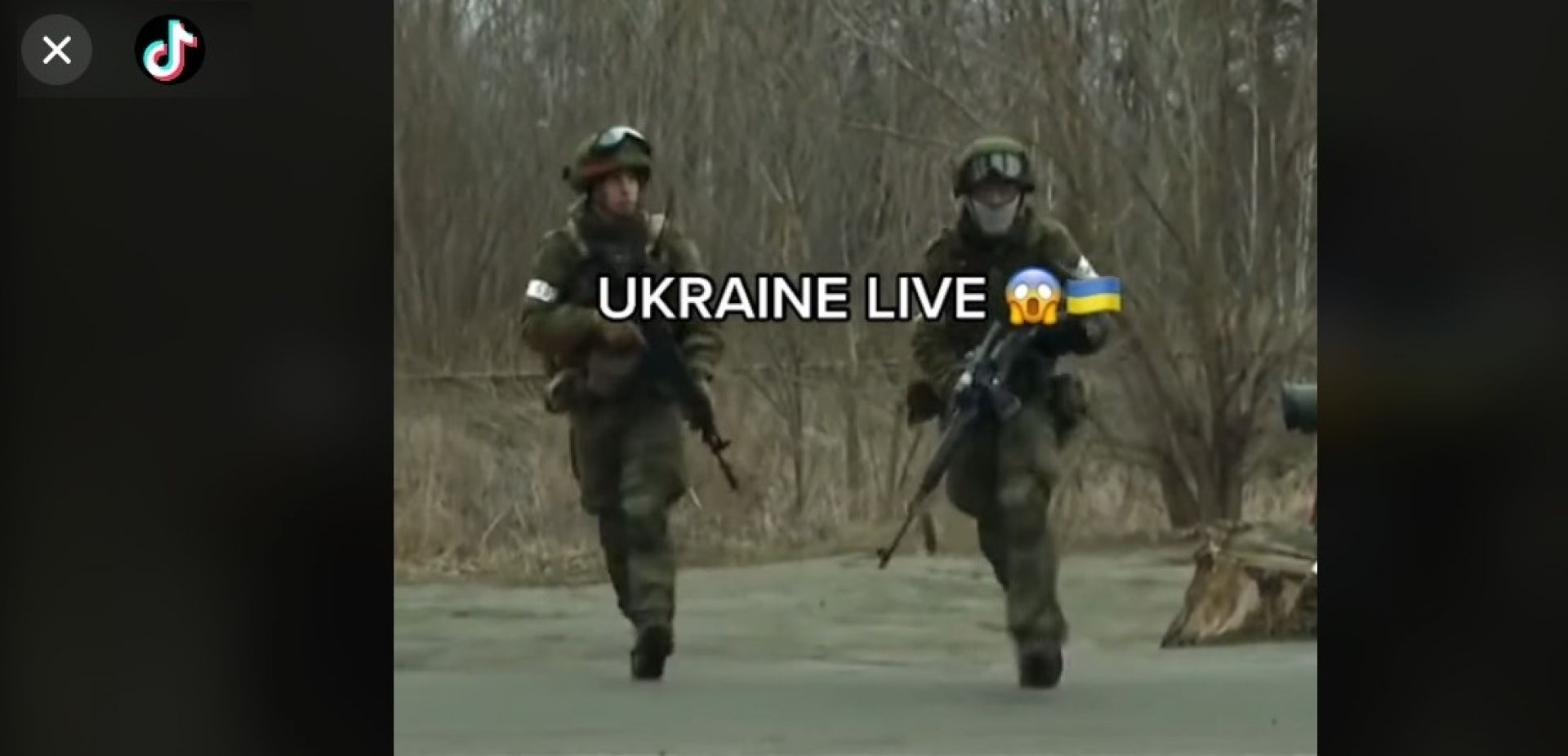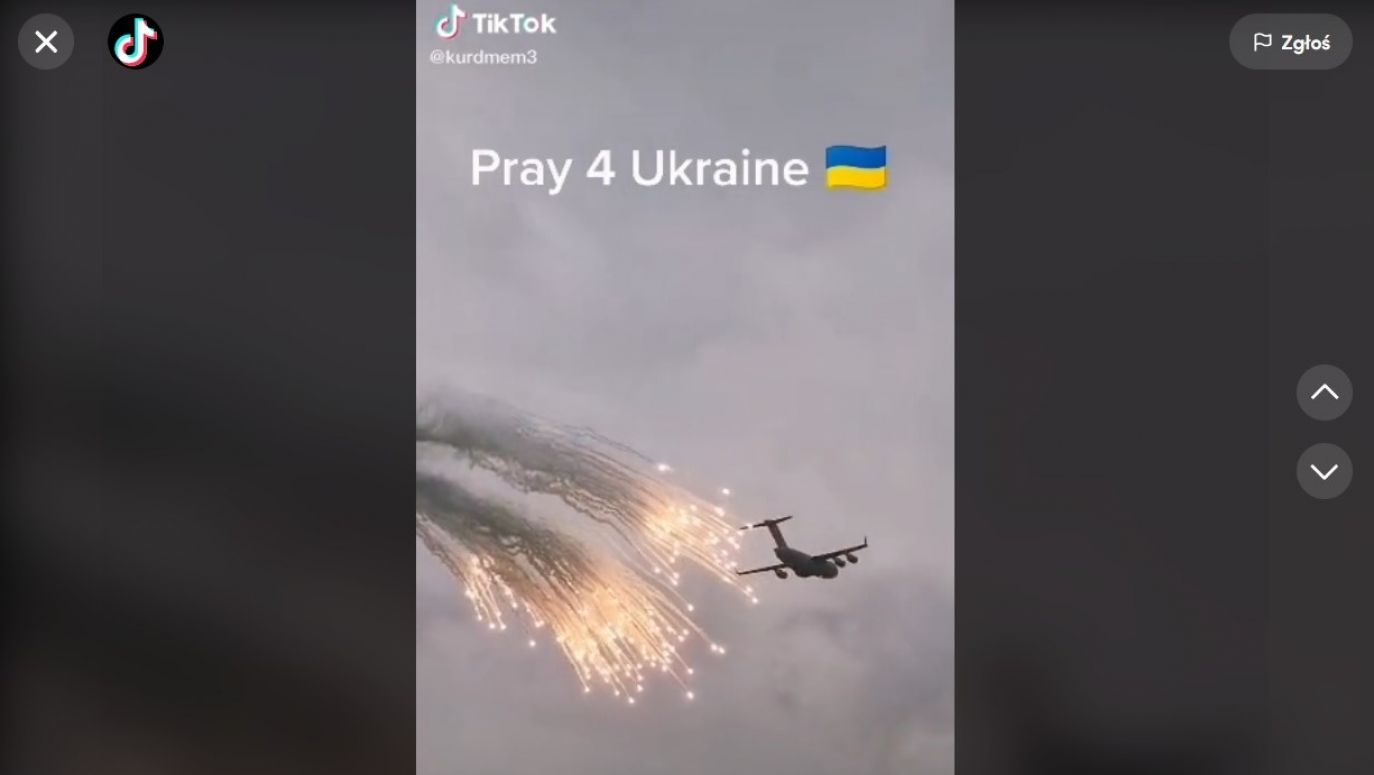War of the TikTok era. Photos, videos, analysis, open-source intelligence, detailed data on losses. Fake news and propaganda
16.03.2022
One blogger – looking at the damaged tyres and hubs of Russian vehicles – concluded that they must have been in a deplorable state even before they left their bases. Same goes for the Pancyr-S1 self-propelled anti-aircraft systems. Further evidence of poor servicing: fluid leaking from vehicle hubs. The result? A huge number of abandoned equipment.
Russia’s aggression against Ukraine is the first ever war on such a scale, which can be watched almost in real time on computer screens or smartphones. Thanks to social media platforms such as TikTok, Telegram, Twitter and Facebook, we have the chance to know and see more, and access the information faster than through traditional media reports. The English-speaking internet, especially Twitter, offers not only photos and recordings, but – for the most discerning – expert analysis of events on the frontline and discussions of tactics and strategies of the warring parties.
The key word is OSINT – Open-Source Intelligence or “white intelligence”: getting information from publicly available sources and then analysing it. Thanks to the widespread use of smartphones in war zones, the internet is virtually flooded with images from the theatre of war. The recordings are often provided by the soldiers themselves, the Ukrainian army or the government, who – though it may be hard to believe after previous experiences – are so far winning the information war against Putin’s services.
However, without a critical approach – verification of sources, use of geolocation, as well as experience and knowledge of the armament, tactics and weaponry of the Russian and Ukrainian armies – one can either be fooled by so-called “fake news” or adopt the narrative of one of the warring parties, which always try to extract only favourable information for themselves from the typical “fog of war”.
Smartphones tell the story of war
Trying to piece together a complete picture of the war from social media posts is a phenomenon of the last few years. The 2014 conflict in Ukraine and the Russian annexation of Crimea already had a strong presence on social media, with the Russians seemingly masterfully exploiting it (which included targeting reckless Ukrainian soldiers who, by live-streaming, risked their positions being exposed and entire units destroyed).
Later, a team of international journalists was made famous; researchers from the British website Bellingcat. Their biggest successes were identifying the Russian perpetrators of the downing of passenger plane MH17 in July 2014, and the attempted poisoning of Sergei Skripal and his daughter in the British city of Salisbury (February 2018), and also vetting the actions of the Russians and the Assad regime in Syria.
One of Bellingcat’s employees, Christo Grozev (@christogrozev) reports on the fly on what is happening in Ukraine – a few days ago he was the first to reveal the circumstances of the death near Kharkiv of Major General Vitaly Gerasimov, Chief of Staff and Deputy Commander of the Russian 41st Army.
It is not known who first used the term “war of the TikTok era” (TikTok is a Chinese app for sharing short videos, popular especially among teenagers), but according to Rob Lee, this is already the “second TikTok war”, as the first such conflict was the 2020 Nagorno-Karabakh war (27 September—10 November), which, thanks to Lee’s twitter account (@RALee85), we could follow almost in real time.
It was the recordings spontaneously posted on TikTok – alongside Telegram footage and official videos of the warring sides – that were an important source of knowledge about the conflict in the Caucasus. It was then that one could see for the first time exactly how powerful were the Turkish Bayraktar TB2 drones used by the Azerbaijanis against Russian-made military equipment (belonging to the Armenians).
Now Rob Lee – formerly a US Marine infantry officer and currently a PhD student in the Department of War Studies at King’s College, London – is perhaps the most reliable source documenting the war on Twitter (he now has over 412,000 followers), demonstrating a wealth of knowledge about the weaponry and tactics of the Russian armed forces. It should be added that he is rarely wrong.
Having observed the build-up of Russian troops along the border with Ukraine since late last year, he predicted that war was highly likely to break out. “My argument regarding Russia’s behavior: 1) Moscow switched from deterrence to compellence 2) The key issue is Moscow believes Kyiv will remain hostile and is increasing its defensive capabilities 3) the costs of inaction are greater than an escalation,” he analysed on 18 January 2022. Reading Putin’s intentions accurately, Lee has been diligently documenting the war every day since the invasion commenced, publishing photos and videos with detailed descriptions.
A second very good source for tracking losses on both sides is the Oryx account (@oryxspioenkop), whose author keeps a list detailing the equipment of both warring sides. In order for the data to make it onto the list, it is necessary not only to have photos, but also geolocation, and to be sure that it is not a repeat entry.
Status at a few minutes after midnight on 10 March: Russians – 969 vehicles, artillery units, aviation (of which 159 tanks, 98 armoured fighting vehicles, 11 aircraft) destroyed, abandoned and seized by Ukrainians. On the Ukrainian side, losses in equipment amount to 274 (including 46 tanks, 38 combat vehicles, 8 aircraft).
Russia will lose because of trucks? <
The most fascinating analyses are those conducted by people who seem to know what they are writing about. Blogger and historian with experience working for the US Department of Defense Trent Telenko (@TrentTelenko) looked at the tyres and hubs of Russian wheeled vehicles during the first days of the invasion. And he concluded that Russian vehicles must have been in a deplorable state even before they left their bases. Each should have been moved at least once a month to eliminate the effects of sun and weight on the tyres, which was clearly not being done.
Analysing photos of abandoned Pancyr-S1 self-propelled anti-aircraft sets (worth $13-14 million apiece), Telenko concluded that no one had moved them... for a year. “If the Russian Army was too corrupt to exercise a Pantsir-S1, they were too corrupt to exercise the trucks & wheeled AFV’s [armoured fighting vehicles] now in Ukraine,” he wrote.

Hundreds of millions of bottles streamed into Germany. Many wineries made fortunes.
see more
Further evidence of poor servicing: fluid leaking from the hubs of immobilised vehicles (“you would have to have not moved the vehicle for at least a year for something like this to happen”). The result? A large number of vehicles – documented on photographs – abandoned due to tyre problems. And the forced adherence to the roads, because with the state of the tyres, every off-road descent ends with getting stuck for good in the Ukrainian mud.
Add to this the logistical nightmare of too few supply vehicles (“the Russian Army now seems to have fallen prey to one of the great temptations of many militaries created by dictators--lots of flashy weapons but little consideration about how to deliver them,” wrote strategy professor Phillips P. OBrien @PhillipsPOBrien), resulting in fuel shortages, and you have a situation that the Ukrainians are ruthlessly exploiting.
Hence so many pictures of supply convoys under attack, and “seven burnt Kamaz tankers equals 35 paralysed Russian tanks. And thus they are more likely to be attacked or abandoned,” one internet user commented under pictures of a destroyed transport column.
One must also bear in mind the expired rations found by the Ukrainians. An encrypted communications system that only works within the official communications system. An air force unable to coordinate its actions with ground units…
As Russian armed forces analyst Michael Kofman (@KofmanMichael) wrote in a comment on Twitter: “Taking a cursory look at Russian losses two weeks into the war, it reads less as a general failure to modernize, and more as a failure to maintain and properly support the equipment. Abandonment rate exceedingly high.”
Or even more bluntly, as Andrei Kozyrev, the first Minister of Foreign Affairs of the Russian Federation under Yeltsin, wrote – it is the result of corruption: “The Kremlin spent the last 20 years trying to modernize its military. Much of that budget was stolen and spent on mega-yachts in Cyprus. But as a military advisor you cannot report that to the President. So they reported lies to him instead. Potemkin military.”
Armoured roller versus tractors<
Looking through social media, one would get the impression that the Russian army is on the verge of collapse. For example, pictures of Ukrainian farmers towing away abandoned Russian vehicles are very popular. There was even a meme referring to the computer game “Grand Theft Auto”: with a tractor pulling a Russian tank…
It is worth remembering, however, that regardless of the mockery on Twitter, the Russians, albeit slowly, are advancing and gaining ground. Despite mistakes, poor morale and supply shortages, using brutal bombing and shelling methods (familiar from Syria and Chechnya) – they established a foothold. The number of troops and the amount of equipment still favour the Russians.
The picture of the war may be misleading; only in the last few days images illustrating Ukrainian losses have also started to appear. This may be due to the fact that Putin’s propaganda machine, so well-oiled before the war, was not prepared for such a course of the fight. It was supposed to be a few days’ rapid “military operation” (and not a war, so as not to irritate the Russians), after which parades and people rejoicing at the liberation would be shown.
However, even if one is heartily on the side of the Ukrainians, one has to approach with caution all kinds of official narratives and breaking news delivered by the media. These are often stories that are “too good to be true” (such as the widely reported tale of the 13 defenders of Snake Island who were supposed to have died heroically in these “Ukrainian Thermopylae” with a cry “Russian warship, go f--- yourself!" – and after a few days it turned out that they were alive and in captivity). Truth is the first casualty in war, especially one tracked on social media, where algorithms are set to confirm information from one’s own information bubble rather than suggesting generally advised scepticism.
As John Schindler (@20committee), who runs The Spy Brief, a paid channel covering intelligence and strategy issues, pointed out, you can oppose Putin’s aggression and cheer for Ukraine, but you should not confuse war propaganda with factual analysis. He illustrated this with a perverse post on Day 14 of Russian aggression: “If social media had existed back then, by September 14, 1939, for two weeks we would have been looking at carefully selected photos showing dead Germans, destroyed tanks, horrific images of dead Polish civilians... and ignored the information that Warsaw was surrounded and the Polish Army – though fighting bravely – was losing.”
Senator reveals intelligence?
That the Ukrainian farmers have not yet defeated the Russian army, and that the Ukrainians have got difficult days or even weeks ahead of them, Florida Senator Marco Rubio has no doubt. The Republican running for re-election is engaging with the war in Ukraine on his Twitter account like probably no other American politician. As the top Republican on the U.S. Senate Select Committee on Intelligence, he is part of the so-called Gang of Eight – the eight most important senators and congressmen who receive intelligence-based reports on a regular basis.

The lord of the Kremlin is attempting to prove to the people of Ukraine that they are the poor kinsmen of the Russians, who they should be grateful to for what they have.
see more
Although Rubio denies sharing classified information, some suggestive posts (such as questions about Putin’s health) may give the impression that he has permission to make public some information that few people want to talk about. The senator has spent the last few days sounding the alarm about the possibility – in view of insufficient progress in Ukraine – of a Russian attack using chemical or biological weapons, and then accusing the Ukrainians of it.
Most of the senator’s posts are strongly pro-Ukrainian. However, even with this politician one senses anxiety that the Russians will increase military pressure. Marco Rubio, in his March 9, 2022 entry, laid out the tenets of the Russians’ actions in the coming days: “1) Expand encirclement of Kiev from the west, north and east; 2) Stage for offensive on Odessa; 3) Seize Mariupol; 4) Convince local officials in Chernihiv, Kharkiv, Nikolaev and Zaporizhia to either surrender these cities or face annihilation.”
Despite losses and moderate success in the first two weeks, the Russian “war roller” is not slowing down, continuing its work of destruction.
– Paweł Burdzy, New York
– Translated by Jan Ziętara









